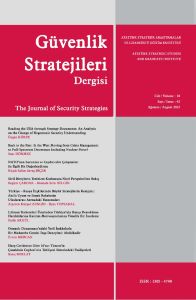NATO’nun Savunma ve Caydırıcılık Çalışmaları ile İlgili Bir Değerlendirme
An Assessment on NATO’s Defence and Deterrence Studies
Author(s): Rüştü Salim Savaş BiçerSubject(s): Politics / Political Sciences, International relations/trade, Security and defense, Military policy, Peace and Conflict Studies
Published by: Atatürk Stratejik Araştırmalar Enstitüsü
Keywords: Defence; Deterrence; Instability; Security; Alliance; NATO;
Summary/Abstract: NATO developed its last concept for deterrence and defence in 1967 to address potential military conflict with the Soviet Union. At the end of the Cold War, the Alliance shifted from its main concept of guiding deterrence and defence actions to supporting military reaction towards various forms of instability. Bases of instability at the time included terrorism, reform problems in post-Soviet Russia, nationalism, authoritarianism, ethnic, sectarian, and local conflicts, economic destabilization, natural disasters, and civil wars. Consequently, Alliance’s responses to instability since 1991 were various, each addressing a specific challenge on a case-by-case basis. Instability continues to be persistent and diverse and holds risks for damaging Allies’ security. Nowadays, instability continues to risk the security of widely different subjects. Two forms of instability identified in the early 1990s, which are Russia and Terror Groups, have emerged as challenges on a strategic scale with aims and patterns that can weaken and threaten the security of an Ally, a group of Allies, or the Alliance as a whole. These two challenges are strategic in terms of geographic scale and the impact they have on their targets, considering the possible risks they will create for the security of the Alliance and their ability to persist in the long term. A new Euro-Atlantic Area Defence and Deterrence Concept Paper is needed to counter these security risks within NATO’s strategic scope and 360-degree range and support the implementation of the Alliance’s three main tasks: collective defence, crisis response, and security cooperation. In this research, NATO’s latest deterrence and defence studies, which have started to be updated in parallel with the changing security environment, will be analysed.
Journal: Güvenlik Stratejileri Dergisi
- Issue Year: 18/2022
- Issue No: 42
- Page Range: 323-346
- Page Count: 24
- Language: Turkish

